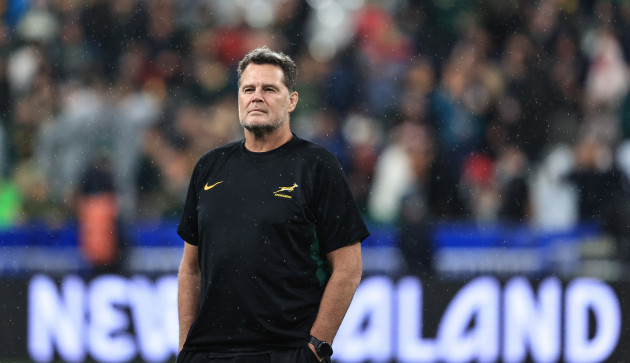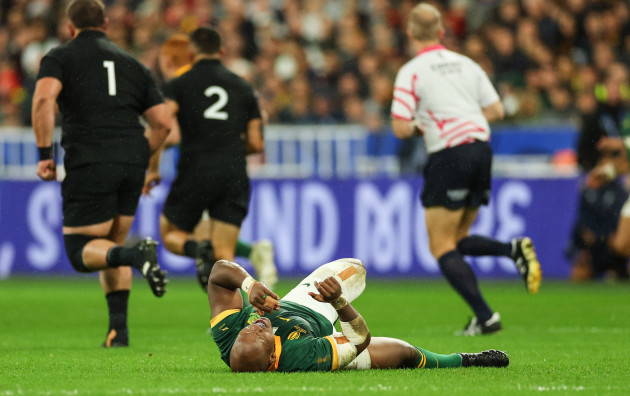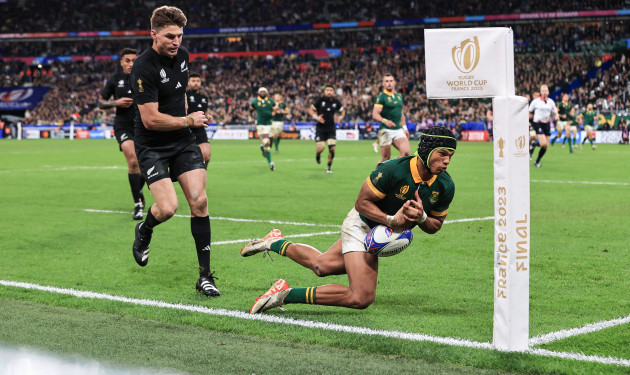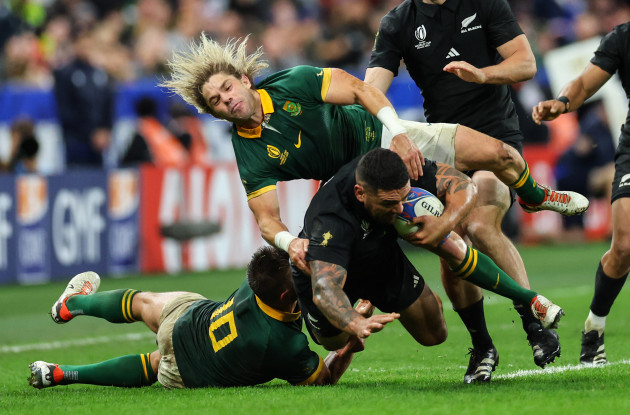AS THE CLOCK wound down Cheslin Kolbe cut a lonely figure. Forced to watch the final 10 minutes from the sideline after his late yellow card, the South Africa winger stuck his head inside his jersey, unable to watch the chaos that was unfolding before him, the one spectator willing to draw their eyes away from this utterly enthralling contest.
In the end his tears were ones of joy as South Africa made history with a 12-11 defeat of New Zealand in Paris, doing it in the most chaotic fashion. All of their points came in the opening 40 minutes, but as New Zealand put everything into a remarkable second-half resurgence, the Springboks had enough to hold them off and clinch a stunning victory that cements their status as one of the all-time great rugby teams.
To think that with just two minutes played, it looked as though it may be about to go horribly wrong for the defending champions. Bongi Mbonambi, the only recognised hooker in the South Africa squad, was on the turf holding his knee after a nasty neck roll from New Zealand flanker Shannon Frizell. After the TV cameras offered a glimpse at a tense looking South Africa coaching box, Mbonambi – who went 74 minutes in the quarter-final win against France and 80 against England last week – made way for Deon Fourie, the veteran flanker tasked with playing back-up hooker at this tournament.
Maybe this was going to be the moment their luck ran out. Throughout this tournament, South Africa have rolled the dice and lived to tell the tale. When hooker Malcolm Marx had to head home with an injury, they decided to fill his place in the squad with out-half Handre Pollard, who missed out on the initial selection as he worked his way back from a calf problem. That decision made the fitness of Mbonambi a crucial part of the Springboks plan. Now that plan was ripped up just moments after kick-off.
And yet, it was South Africa who brought the game to a New Zealand team who just didn’t look at the same pitch. Any New Zealand player who decided to hold the ball for more than two seconds soon found themselves being crushed by Pieter Steph du Toit. Siya Kolisa wasn’t too far behind him, while Kolbe harried and chased and kicked and tackled with the energy of a giddy sheepdog.
New Zealand were under pressure, but for the most part, their problems were self-inflicted. Frizell was extremely fortunate not to have his yellow card upgraded to red. Just shy of the half hour mark, captain Sam Cane found himself in the bin for a shoulder to the head of Jesse Kriel. Before the half was over he’d see the card upgraded to red and two weeks after delivering the performance of his life in the quarter-final defeat of Ireland, the New Zealand captain became the first men’s player to be sent off in a World Cup final. It was a horrible moment for a man who knows full well how unforgiving the New Zealand media and public can be.
After playing more than half of the opening 40 minutes with just 14 men, the All Blacks found themselves trailing 6-12 at the break, Pollard kicking all the points for South Africa, Richie Mo’unga doing same for New Zealand.
Given all that had transpired in that helter-skelter first half, it wasn’t the worst place to be, but all of this had unfolded before South Africa had turned to the controversial tactic which was always going to colour the discussion around the result.
To opt for a 7/1 bench split in a World Cup final is the type of risk no other nation would even dream of taking. We’d seen it before, of course, but the game was already won when South Africa released their ‘Bomb Squad’ against New Zealand in their final warm-up fixture and when they backed their magnificent seven again against Ireland in the pool stages, Andy Farrell’s side came out on top. This was to be the real test of a team selection which was met with utter shock when South Africa revealed their hand during the week. The risks involved are huge, and if it was to all unravel on the biggest night of all, Rassie Erasmus and Jacques Nienaber would have faced difficult questions.
New Zealand knew what was coming from that South Africa bench and needed to summon a response after the restart, but instead they looked utterly rattled – their handling repeatedly letting them down while Beauden Barrett delivered a nightmare five minutes, the fullback extremely lucky to see Kurt-Lee Arendse drop the ball after he nipped in to steal a bouncing ball in the corner.
A wild night took another turn when South Africa captain Kolisi saw yellow for a high hit on Ardie Savea. With 35 still to play, it was 14 v 14 and a six-point game.
Enter the Bomb Squad, with RG Snyman and Ox Nche – the man so pivotal in turning the momentum against France and England – the first off the bench as confirmation arrived that Kolisi’s yellow was not to be upgraded.
Then another huge moment. Mo’unga seared forward from a lineout before playing in Aaron Smith. The Stade erupted only for the score to be crossed of as Ardie Savea had knocked the ball on at the lineout. It could have felt like a killer blow, but instead it felt like a warning shot. When the stakes are so high, New Zealand are never dead.
With penalty advantage they hammered at South Africa before swinging the ball wide, Mark Telea stepping inside before Beauden Barrett swept in to score the opening try of the game, and the first South Africa have ever conceded in a World Cup final. Mo’unga’s conversion pushed wide and New Zealand trailed by one.
Game on. South Africa responded by powering up their pack again, sending in Jean Kleyn and Kwagga Smith, but the champions were creaking. Fourie lost two lineouts in quick succession. Smith began to move the ball with greater purpose. Brodie Rettalick hit every ruck like a bulldozer. Savea looked like he might turn the tide all by himself.
New Zealand’s surge sparked South Africa into their second wind. Kolbe smashed Will Jordan before spotting a gap and haring forward, only to be met by a crunching collision with Smith. Fourie pulled up with cramp. So did Faf de Klerk. Blood seeped out of a deep cut on Pollard’s cheek. Big players made the big plays. Somehow, there was 25 minutes still to play.
It was World Cup rugby at it’s thrilling, breathless best, but now it was South Africa making the wrong decisions, Kolbe lining up an audacious drop-goal from distance and producing the Springboks’ third drop-goal miss of the night.
Moments later, the same player was caught for a deliberate knock-on. The yellow card meant South Africa would be down to 14 for the final eight minutes. From distance, Jordie Barrett took on the kick, and spun it inches wide. It was the chance.
South Africa tried to kill it. Pollard saw another drop goal attempt blocked down. Du Toit was chopped to ground as he charged down the left flank. De Klerk clipped Dalton Papali’i with a crucial tap-tackle. Every time a black jersey moved forward, two green ones clamped on to him as the Springboks went to well and summoned a remarkable defensive effort. On the sideline, Kolbe agonised.
New Zealand went again, and of course, it came down to a scrum. As the clock hit 80, South Africa won on their own put-in and as the bodies spilled over towards the touchline, Wayne Barnes called time.
History for South Africa, who become the first team to win the World Cup four times. They were bold, they were brave, and in typical South Africa fashion, they did it their own totally unique way.





